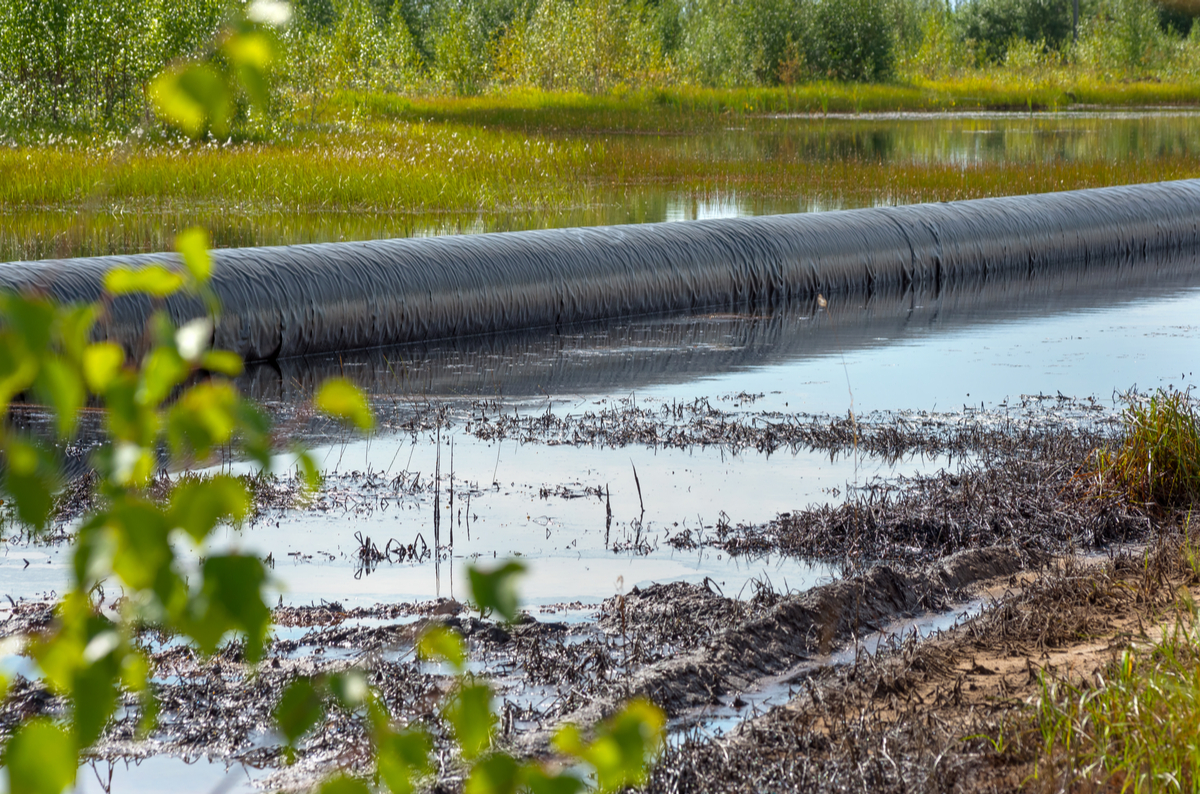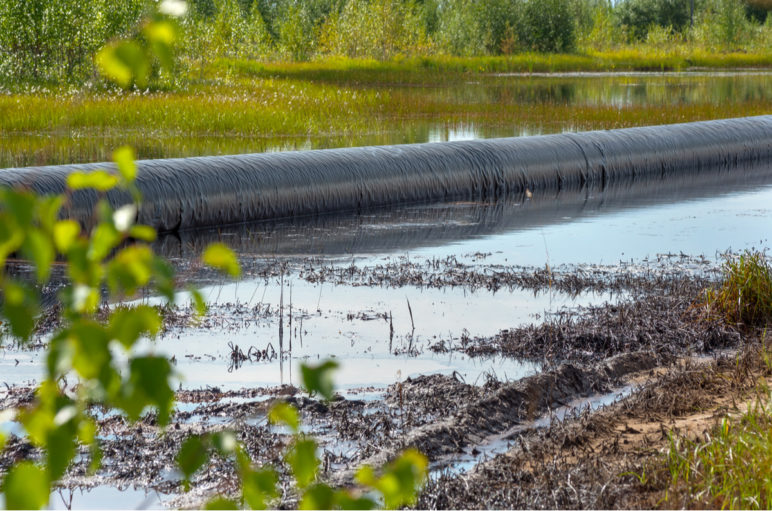Pollution occurs in every phase of the oil refining process. In this series, we analyze the impacts of pollution in three categories: direct pollution from the refinery operations themselves; “upstream” and “downstream” pollution from transporting crude oil and refined products;1 and indirect pollution from consuming the refineries’ products. It’s important to consider all three categories because Northwest refineries do not exist in isolation. Rather, they sit at the center of a sprawling web of petroleum infrastructure.
The coming decades will bring increasingly volatile oil markets as well as promising boosts in energy efficiency, vehicle electrification, and a shift to cheaper clean energy. As demand for oil drops, Puget Sound refinery communities can plan ahead for a smooth transition—protecting workers, local economies, and the environment to build a thriving and resilient future. This article is part of a special series on the issue.
Transporting crude oil to, and refined product from, oil refineries inherently carries the risk of environmentally destructive spills. The environmental damage from oil spills can last decades. Oil spills harm fragile ecosystems, cause health problems for impacted animals, and can be extremely difficult to contain. As long as oil is transported through Cascadia, spills will be a fact of life.
Northwest refineries receive crude oil—the raw material they use to manufacture consumer fuels—via three modes of transportation: pipeline, trains, and marine vessels. After the refining process, the refined products are transported to consumers by pipelines, trains, marine vessels, and trucks. In this chapter, we examine the risks, impacts, and costs of transporting crude oil and refined products by pipeline and train.
Pipeline Risks in Cascadia
The four refineries in Skagit and Whatcom Counties are served by the Puget Sound Pipeline, which forks south from the larger Trans Mountain Pipeline in British Columbia. Both are owned by the government of Canada and both deliver mostly heavy oil—tar sands or “diluted bitumen”—from Alberta. Some of the oil is piped directly to the refineries, while some oil is loaded onto vessels in Burnaby, British Columbia and either shipped to destinations outside the Northwest (principally California) or barged to Puget Sound refineries, including the small facility in Tacoma.
Living near a crude oil pipeline can be risky. In 2007, for example, the Trans Mountain Pipeline ruptured in Burnaby, forcing 50 families to evacuate their homes as nearly 60,000 gallons of crude oil rained down on a residential neighborhood.
“Some witnesses said oil shot 30 metres into the air like a geyser for 25 minutes. The black liquid rained down on houses, spewed across two lanes of traffic and ran downhill into [Burrard Inlet].”
“We smelled oil and the smell of gas in [our] home,” said one resident, Natalie Marson. “Next thing I know, we heard a frantic knock and it was police officers telling us to get out.” In 2007, a Kinder Morgan pipeline ruptured in Burnaby, British Columbia.
Abbotsford, a Vancouver suburb, experienced two large spills in just the last decade. In 2012, an oil pipeline storage facility spilled roughly 29,000 gallons of crude oil, the response to which was delayed by four hours. Another spill occurred in 2020, in which between 40,000 and 50,000 gallons of crude spilled due to a failed pipeline fitting.
The largest crude oil pipeline spill in Washington state history occurred in January 1973, when a cracked pipe in the Trans Mountain pipeline caused a spill near Bellingham.2 Initial reports estimated the spill around 10,000 gallons, but within two weeks at least 300,000 gallons was reported to have spilled.3 Ultimately, 460,000 gallons of crude spilled.4 The Department of Ecology fined the Trans Mountain Pipeline Corporation the maximum $20,000 for “operating negligently.”5
Washington has been more fortunate in recent decades, thanks in large part to a series of laws passed in the early 1990’s establishing the regulatory framework which continues to be updated today. According to the Pipeline and Hazardous Materials Safety Administration, Washington’s 70 miles of crude oil pipeline have not experienced a spill since 2001.
Washington’s pipeline infrastructure is not limited to crude oil. The Olympic Pipeline transports refined petroleum from Ferndale and Anacortes all the way south to Portland. The Olympic Pipeline has a history of spills, including the deadly 1999 explosion in Whatcom County. That explosion killed three people, two 10-year-olds and one 18-year-old, and contaminated Hanna and Whatcom Creeks with over 236,000 gallons of gasoline. The explosion started a fire and burned down 26 acres of trees and vegetation, as well as causing unquantified damage to aquatic wildlife like salmon. The Pipeline and Hazardous Materials Safety Administration reports 22 refined product spills in Washington from 2001 to 2020. These spills were all relatively minor, with the largest spilling 25,000 gallons of jet fuel from the McChord Pipeline.
Still, the risk is real and ever present. When similar pipelines carrying the same type of oil have failed in other places, they have resulted in catastrophes.
Warnings from Around North America
Pipeline incidents are most prevalent in Texas, Oklahoma, and Louisiana. But they happen wherever pipelines exist. Two examples below illustrate the potential dangers.
In July 2010, at Marshall, Michigan, “corrosion fatigue” opened a six-and-a-half foot long rupture in a pipeline carrying diluted bitumen from the Alberta tar sands. The failure allowed 843,000 gallons to spill into Talmage Creek, just upstream from where it enters the Kalamazoo River. Once in the river, the constituent parts of the oil separated–the lighter “diluents” evaporated while the heavier bitumen sank—rendering most conventional spill clean-up techniques useless.
In the aftermath of the spill, the Kalamazoo River became a case study in the challenges of cleaning up tar sands oil. When exposed to sunlight on land or the riverbank, the bitumen formed a dense, sticky substance—likened by some local residents to chewing gum—that was very difficult to remove from rock and sediments. Michigan state officials closed fishing, swimming, and boating on the river and forced 150 families from their homes for the duration of the cleanup. Volatile Organic Compounds (VOCs) found in the bitumen caused extremely foul odors and led to headaches, dizziness, nausea, and vomiting in local residents. The spill killed hundreds of birds and other animals, including many freshwater turtles, while locals took thousands more to wildlife rehabilitation centers.
All told, the cleanup effort cost the pipeline company $1.21 billion, of which around $40 million dollars are expected to be fines from the EPA and the US Department of Transportation, which regulates pipeline operators. The US Environmental Protection Agency estimates that as much as 180,000 gallons of bitumen remain in the river, of which 90 percent will likely persist even after Enbridge completes dredging about 540,000 cubic yards of contaminated sediment from the river bed.
In March 2013, Mayflower, Arkansas, just north of Little Rock, experienced a similar disaster when an Exxon pipeline burst. The burst pipeline sent 210,000 gallons of diluted bitumen literally flooding into the town. Around 25 families with oil on their property were evacuated, but many others remained in the neighborhood. Dozens of residents, including local elementary school students, experienced dizziness, nausea, and vomiting as long as 10 months after the initial spill. Officials detected dangerous levels of chemicals like benzene, a well-known carcinogen, and hydrogen sulfide, a toxic and corrosive gas.
Property values plummeted in the previously high-end subdivision where the spill occurred, while dozens of birds and turtles were killed as the oil flowed through wetlands and into a nearby lake. By November 2013, officials were estimating the cleanup costs of the spill at $70.5 million, though the cleanup was not yet completed.
With luck, the Northwest will never experience a catastrophic pipeline rupture. It has not been so fortunate with the tanker vessels and trains that also deliver crude oil.
Oil Train Explosions Are Potential Financial Boondoggles
The most recent oil-by-rail accident in the Northwest happened on December 22, 2020, when yet an oil train bound for a Ferndale refinery derailed and caught fire. By the end of the disaster in Custer, Washington, the derailment had spilled 29,000 gallons of crude oil from North Dakota, much of which burned in the ensuing blaze that lasted a full eight hours. Cleanup crews did the best they could, but as much as 8,000 gallons of crude oil will continue to contaminate the site.
As bad as the Custer disaster was, the region got lucky. The train had just passed through downtown Bellingham when it derailed in an area away from major population centers and injured no one. Washington still permits four oil refineries on Puget Sound to accept oil by rail, and these trains deliver a lot of crude through small towns and big cities alike—more than 50 million barrels of crude each year since 2017.
The wreck in Custer was only the latest in a long line of oil train derailments—often resulting in spills or fires—that have plagued North America since they started running roughly ten years ago. The Northwest has seen one other near-miss explosion when a train carrying Bakken crude oil to the Tacoma refinery exploded in Mosier, Oregon on June 3, 2016. A total of 16 tank cars derailed, three of which caught fire, as approximately 50,000 gallons of crude oil leaked, fouling the city’s waste water treatment plant and narrowly avoiding contaminating the Columbia River.
Two years before that, an oil train bound for an Anacortes refinery derailed under the Magnolia Bridge near downtown Seattle in the middle of the night. Although the mishap could have been catastrophic, the tank cars did not rupture.
When they result in fiery explosions, as they often do, oil train crashes can be extremely expensive for the public. That risk was made clear in a 2014 exposé in the Wall Street Journal discovered that the financial risks of a catastrophic derailment fall largely on taxpayers. According to James Beardsley with insurer Marsh & McLennan, there is about $1.5 billion of liability insurance available for a major railroad.
The problem is that the cost for a worst-case derailment scenario is much, much higher.
To understand the risk, Sightline compiled rough estimates using things like lawsuits against railroads that have released hazardous materials, insurers’ estimates for comparable events like terrorist attacks, and estimates used by federal regulators for cost-benefit analysis.
A damage assessment report prepared in 2006 by the American Academy of Actuaries for the President’s Working Group on Financial Markets analyzes terrorism risk. The Actuaries group ran through several scenarios of insured loss estimates in variously sized cities. They pegged the cost for the closest analogy, a truck bomb, at $3 billion for Des Moines, $8.8 billion for San Francisco, and $11.8 billion if the incident occurred in New York City.
More telling was the Regulatory Impact Analysis for oil trains, produced by the US Pipeline and Hazardous Materials Safety Administration (PHMSA), which estimated upper-end damages for a derailment causing a “higher consequence event” in an area of average population density along a train route, pegging those costs at $1 billion for lives lost, property ruined, and the cleanup. If the event were to take place in an area five times as dense, as in an urban center like Spokane or Seattle, where oil trains travel regularly, PHSMA said the event would produce roughly $5 billion in total damages.
Yet the railroads now delivering oil to Northwest refineries could cover only a fraction of those costs if a major crash were to occur in Cascadia. And the longer the refineries operate and receive crude oil via train, the greater the chance of environmental and financial catastrophe.
The next chapter will examine the remaining mode of oil transportation, marine vessels.
This article benefited from past research by John Abbotts, Nick Abraham, Rich Feldman, Pam MacRae, Clark Williams-Derry, and Jerrell Whitehead.










